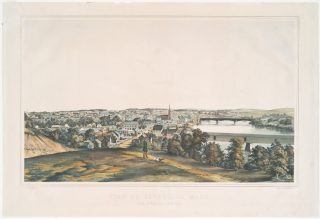Haverhill Painting Company
★★★★★
Proline Painting Company: Your Trusted Painting Contractor in Haverhill, MA
In Haverhill, MA, when it comes to top-quality painting services, Proline Painting Company stands as a benchmark. Our professional team of skilled painters caters to both residential and commercial clients, delivering results that not only meet but exceed expectations. The Proline Painting Company, based in Haverhill, MA, is a one-stop solution for all your painting needs, promising you an outcome that’s nothing short of perfect.
Do You Have These Problems?
- Difficulty finding a reliable painting company that delivers on their promise of quality?
- Experiencing delays and lack of professionalism from your current painting service?
- Struggling with painting companies that overcharge and fail to provide value for your money?
- Having trouble finding a painting service that offers both residential and commercial services?
- Concerned about the environmental impact of your painting projects?
Local Painting Company: Proline Painting Company — Haverhill, MA
Proline Painting Company is proud to serve Haverhill, MA as a local painting company with a solid reputation. With over a decade in business, we’ve built a name for ourselves by consistently delivering premium quality painting services. Our team comprises professionals who bring along years of experience, skill, and a deep understanding of how color impacts a space. As a local company, we’re deeply invested in our community and strive to improve it one painting project at a time.
Commercial Painting Services
At Proline Painting Company, we understand the unique requirements that commercial painting projects entail. Our Haverhill team is trained to deliver fast and efficient services without disrupting your business operations. We handle everything from offices, retail stores, restaurants to large commercial complexes. With our commercial painting services, we guarantee a visually appealing workspace that embodies your brand identity and enhances productivity.
Residential House Painting Services
Home is where the heart is, and at Proline, we take that to heart. Our residential painting services are designed to transform your home into a space that reflects your personality and style. We treat every project with the same level of importance, whether it’s a single room or the entire house. Our professional painters in Haverhill work diligently to ensure a clean, efficient, and timely completion of the project, resulting in a beautifully painted home that you can be proud of.
Painting Contractor Process
At Proline, we follow a systematic painting process to deliver top-notch results. Our painting process starts with an in-depth consultation where we understand your vision and requirements. We then prepare the area by protecting furniture, fixtures, and flooring, followed by surface preparation, which includes washing, scraping, sanding, and priming as needed. The final step is the application of the chosen paint in a meticulous manner. Our transparent process ensures you’re aware of each step we undertake to bring your vision to life.
Haverhill’s Most Affordable Painters Rates
Our commitment to our clients extends to our pricing as well. At Proline, we believe in providing exceptional service at fair prices. Our painting company rates are competitive and transparent, with no hidden costs. We provide detailed estimates upfront, allowing you to understand exactly what you’re paying for. Our goal is to offer top-tier painting services that deliver excellent value for your investment.
5 Star Rated Painting Company Reviews
We take immense pride in the positive reviews we’ve received from our satisfied clients. Their words not only inspire us but also serve as a testament to our commitment to excellence. Our painting company reviews reflect our high standard of service, our professional approach, and our attention to detail. We encourage prospective clients to read these reviews to understand why Proline is a top-rated painting company in Haverhill, MA.
Searching For a Painting Company Near You
If you’re searching for a reliable, professional, and affordable painting company near you, look no further than Proline Painting Company. Based in Haverhill, MA, we offer comprehensive painting services to meet a variety of needs. We’re just a call away from transforming your space with high-quality, long-lasting paint jobs.
Painting Company Jobs In Haverhill, MA
At Proline, we believe that our strength lies in our team. We’re always on the lookout for dedicated individuals to join us in delivering outstanding painting services. If you’re looking for rewarding painting company jobs, we encourage you to explore the opportunities at Proline. We offer a supportive work environment, competitive pay, and opportunities for growth.
Eco-friendly Painting Company
As an eco-friendly painting company in Haverhill, we are committed to minimizing our environmental impact. We use low-VOC or VOC-free paints whenever possible and adhere to practices that reduce waste. Our goal is to deliver beautiful paint jobs while respecting the planet and contributing to a healthier environment.
Beloved House Painters in Haverhill, MA
5-Rated On Google For Painting Contractors
Your home is not just a house and a structure with walls, ceilings, doors, rooms and windows but it serves as an expression of yourself, your character, and your personality. Our painting contractors have carefully picked local house painters who are ready to start a painting project with you! These expert painters will make sure that any painted room is a pleasant experience. At Proline Painting Service, we know that you will not settle for less, and that is why we have to ask you to consider one of the most respected painting contractor in Haverhill, MA.
- Haverhill Painting
- Full Service Painting Company
- Painting Services
- Haverhill Painters Cost & Pricing
- Commercial Painters
- Painting Contractors
- Commercial Painting Contractors
- Exterior Painting
- Interior Painting
- Cabinet Painting
- Haverhill Contractors
- General Contractor
- Home Remodeling Contractors
- Remodeling Contractors
- Drywall Contractors
- Kitchen Remodeling
- Bathroom Remodeling
- Basement Remodeling
- Office Painters
RESIDENTIAL & COMMERCIAL
Haverhill Painting Company
Painting Company FAQs
How much does your painting service cost?
Every painting project is unique, and the cost can vary based on the size of the area, the complexity of the work, and the type of paint used. We provide a detailed, no-obligation estimate after assessing the project.
Do you offer commercial and residential painting services?
Yes, we provide both commercial and residential painting services. Our team has the expertise to handle projects of all sizes and complexities.
How long does a painting job usually take?
The duration of a painting job depends on several factors, including the size and condition of the area to be painted and the type of paint used. Once we assess your project, we can provide a more accurate timeline.
Can you provide references or examples of previous work?
Absolutely! We are more than happy to share references and examples of our work. Customer satisfaction is our top priority, and we are proud of the work we do.
What type of paint do you use?
We use only high-quality paints from reputable manufacturers. The specific type and brand of paint will depend on the project requirements and your preference.
Are your painters insured and licensed?
Yes, all our painters are fully insured and licensed. We believe in maintaining the highest standards of safety and professionalism in all our projects.
How do you prepare the area for painting?
We follow a thorough preparation process that includes covering furniture and fixtures, cleaning the surfaces, and doing any necessary repair work. Proper preparation is crucial for achieving the best results.
Do you offer a guarantee on your work?
Yes, we stand behind our work and offer a satisfaction guarantee. If there is any issue with the work done, we are committed to making it right.
Can you help with color selection?
Absolutely! We offer color consultation services to help you choose the perfect color palette that matches your taste and complements your space.
Are you an eco-friendly painting company?
Yes, we are committed to eco-friendly practices. We use environmentally-friendly paints and ensure our processes minimize waste and impact on the environment.
How do I choose a painting company?
Choosing a painting company involves considering factors such as experience, reputation, the range of services offered, pricing, and their approach towards customer service. It is also advisable to check reviews and ask for references.
How much do painting companies usually charge?
The cost of painting services varies depending on the scope and complexity of the project. Most companies provide a detailed estimate after assessing the project, allowing you to understand the costs involved.
What questions should I ask a painting company?
You should ask about their experience, licensing and insurance, the type of paints they use, their preparation and cleanup process, and if they offer a warranty or guarantee on their work.
Are there eco-friendly painting companies?
Yes, many painting companies, like Proline Painting Company, are committed to eco-friendly practices. They use environmentally-friendly paints and adopt procedures that reduce waste and minimize environmental impact.
What services do painting companies offer?
Painting companies offer a range of services including interior and exterior painting, commercial and residential painting, color consultation, surface preparation, and more.
How long do painting jobs take?
The duration of painting jobs depends on various factors such as the size of the project, the condition of the surfaces, and the type of paint used. A detailed estimate from the company should provide an approximate timeline.
How do painting companies prepare the area?
Painting companies prepare the area by cleaning and repairing the surfaces, protecting furniture and fixtures, and setting up equipment. A thorough preparation ensures a smooth painting process and superior results.
What type of paint is best for my project?
The best type of paint for your project depends on the surface to be painted, the desired finish, and the environment. A consultation with the painting company can help determine the best options for your specific needs.
Do painting companies provide color consultation?
Many painting companies provide color consultation services to help clients choose the perfect color scheme for their space. They consider factors like lighting, décor, and personal preferences to provide suitable recommendations.
Are all painting companies insured and licensed?
Reputable painting companies are insured and licensed to protect their clients and employees. It’s important to verify this information before hiring a painting company.
Haverhill, MA Facts
Haverhill OVERVIEW
Haverhill, Massachusetts | |
|---|---|
City | |
 Haverhill from across the Merrimack River | |
 Flag  Seal | |
| Nickname: “The Queen Slipper City” | |
 Location in Essex County, Commonwealth of Massachusetts, New England. | |
 Haverhill Location in Massachusetts   Haverhill Location in the United States | |
| Coordinates: 42°47′N 71°5′W / 42.783°N 71.083°W | |
| Country | United States |
| State | Massachusetts |
| County | Essex |
| Settled | 1640 |
| Incorporated | 1641 |
| Incorporated (city) | 1870 |
| Named for | Haverhill, Suffolk |
| Government | |
| • Type | Mayor-council city (Strong Mayor) |
| • Mayor | James J. Fiorentini |
| Area | |
| • Total | 35.70 sq mi (92.45 km2) |
| • Land | 33.04 sq mi (85.56 km) |
| • Water | 2.66 sq mi (6.89 km2) |
| Elevation | 50 ft (20 m) |
| Population (2020) | |
| • Total | 67,787 |
| • Density | 2,051.91/sq mi (792.24/km) |
| Time zone | UTC−5 (Eastern) |
| • Summer (DST) | UTC−4 (Eastern) |
| ZIP Codes | 01830–01832, 01835 |
| Area code | 351/978 |
| FIPS code | 25-29405 |
| GNIS feature ID | 0612607 |
| Website | www |
Haverhill ( HAY-vril) is a city in Essex County, Massachusetts, United States. Haverhill is located 35 miles north of Boston on the New Hampshire border and about 17 miles from the Atlantic Ocean. The population was 67,787 at the 2020 United States census.
Located on the Merrimack River, Haverhill began as a farming community of Puritans, largely from Newbury Plantation. The land was officially purchased from the Pentuckets on November 15, 1642 (One year after incorporation) for three pounds, and ten shillings. Pentucket was renamed Haverhill (after the Ward family’s hometown in England) and evolved into an important industrial center, beginning with sawmills and gristmills run by water power. In the 18th and 19th century, Haverhill developed woolen mills, tanneries, shipping and shipbuilding. The town was home to a significant shoe-making industry for many decades. By the end of 1913, one tenth of the shoes produced in the United States were made in Haverhill, and because of this the town was known during the time as the “Queen Slipper City”.
History
Haverhill has played a role in nearly every era of American history, from the initial colonial settlement, to the French and Indian Wars, and the American Revolutionary and Civil Wars.
17th century
The town was founded in 1640 by settlers from Newbury, and was originally known as Pentuckett, which is for “place of the winding river”. Settlers such as John Ward, Robert Clements, Tristram Coffin, Hugh Sheratt, William White, and Thomas Davis aided in the purchase of Pentuckett. The land was sold by Passaquo and Saggahew who claimed to have permission from Passaconaway, though nothing more is known of these two figures in the historical record and it is not clear whether they were at liberty to sell the land, or indeed whether they had a shared understanding of what such a contract would entail.
Settlers Thomas Hale, Henry Palmer, Thomas Davis, James Davis and William White were Pentuckett’s first selectmen. First Court appointments given to end small causes were given to Robert Clements, Henry Palmer, and Thomas Hale. At the same court, it was John Osgood and Thomas Hale that were also appointed to lay the way from Haverhill to Andover. It is said that these early settlers worshipped under a large oak tree, known as the “Worshipping Oak”.
The town was renamed for the town of Haverhill, England, in deference to the birthplace of the settlement’s first pastor, Rev. John Ward. The original Haverhill settlement was located around the corner of Water Street and Mill Street, near the Linwood Cemetery and Burying Ground. The home of the city’s father, William White, still stands, although it was expanded and renovated in the 17th and 18th centuries. White’s Corner (Merrimack Street and Main Street) was named for his family, as was the White Fund at Boston’s Museum of Fine Arts.
Judge Nathaniel Saltonstall was chosen to preside over the Salem witch trials in the 17th century; however, he found the trials objectionable and recused himself. Historians cite his reluctance to participate in the trials as one of the reasons that the witch hysteria did not take as deep a root in Haverhill as it did in the neighboring town of Andover, which had among the most victims of the trials. However, a number of women from Haverhill were accused of witchcraft, and a few were found “guilty” by the Court of Oyer and Terminer.
One of the initial group of settlers, Tristram Coffin, ran an inn. However, he grew disenchanted with the town’s stance against his strong ales, and in 1659 left Haverhill to become one of the founders of the settlement at Nantucket.
Haverhill was for many years a frontier town, and was occasionally subjected to Indian raids, which were sometimes accompanied by French colonial troops from New France, in which dozens of civilians were murdered. During King William’s War, Hannah Dustin became famous for killing and then scalping her native captors, who were converts to Catholicism, after being captured in the Raid on Haverhill (1697). The city has the distinction of featuring the first statue erected in honor of a woman in the United States. In the late 19th century, it was Woolen Mill Tycoon Ezekiel J. M. Hale that commissioned a statue in her memory in Grand Army Republic Park. The statue depicts Dustin brandishing an axe. Her captivity narrative and subsequent escape and revenge upon her captors caught the attention of Cotton Mather, who wrote about her, and she also received from the colonial leaders a reward per Indian scalp. In recent years some have criticized Hannah Dustin since the Native American Indians she killed and scalped in order to escape were allegedly not her original captors and among the people she killed were young children. Hannah, born Hannah Emerson, is often maligned for coming from a troubled family: in 1676 her father Michael Emerson was fined for excessive violence toward his 12-year-old daughter Elizabeth, who in 1693 was hanged for concealing the deaths of her illegitimate twin daughters; and in 1683 Hannah’s sister Mary was whipped for fornication. There were never any allegations of any sort against Hannah herself.
18th century
In 1708, during Queen Anne’s War, the town, then about thirty homes, was raided by a party of French, Algonquin and Abenaki Indians. Like most towns, Haverhill has been struck by several epidemics. Diphtheria killed 256 children in Haverhill between November 17, 1735, and December 31, 1737.
George Washington visited Haverhill on November 4, 1789. Washington was on a “triumphant circuit” touring New England.
19th century
The Bradford Academy was established in 1803. It began as a co-educational institution, then became women-only in 1836.
In 1826, an influenza struck. A temperance society was formed in 1828.
Haverhill residents were early advocates for the abolition of slavery, and the city still retains a number of houses which served as stops on the Underground Railroad. In 1834, a branch of the American Anti-Slavery Society was organized in the city. In 1841, citizens from Haverhill petitioned Congress for dissolution of the Union, on the grounds that Northern resources were being used to maintain slavery. John Quincy Adams presented the Haverhill Petition on January 24, 1842. Even though Adams moved that the petition be answered in the negative, an attempt was made to censure him for even presenting the petition. In addition, poet and outspoken abolitionist John Greenleaf Whittier was from Haverhill.
The Haverhill and Boston Stage Coach company operated from 1818 to 1837 when the railroad was extended to Haverhill from Andover. It then changed its name and routes to the Northern and Eastern Stage company.
It was Ezekiel Hale Jr. and son Ezekiel James Madison Hale (descendants of Thomas Hale) that gave Haverhill a great head of steam. It was in the summer of 1835, the brick factory on Winter St was erected by Ezekiel Hale Jr. and Son. It was intended to run woolen flannel at a whopping six hundred yards of flannel per day. It was Ezekiel JM Hale, age 21 and graduate of Dartmouth College that came to the rescue when fire destroyed the operation in 1845. He rebuilt the mill at Hale’s Falls, now more than twice as large produced nearly three times the output. Ezekiel JM Hale became Haverhill’s Tycoon. EJM Hale served a term in the State Senate and was much revered in the area. Hale donated large sums of money to build the hospital and library.
Haverhill was incorporated as a city in 1870.
In the early morning hours of February 17, 1882, a massive fire destroyed much of the city’s mill section, in a blaze that encompassed over 10 acres (4.0 ha). Firefighting efforts were hampered by not only the primitive fire fighting equipment of the period, but also high winds and freezing temperatures. The nearby water source—the Merrimack River—was frozen, and hoses dropped through the ice tended to freeze as well. A New York Times report the next day established the damage at 300 businesses destroyed and damage worth approximately $2M (in 1882 dollars).
Annexation
Bradford fits naturally into Haverhill but they were separate towns until January 1, 1897, when Bradford joined the City of Haverhill. Bradford was originally the western part of Rowley until it split from Old Rowley in 1672. In 1850, the East part of Bradford left and was founded as the independent town of Groveland. When Haverhill became a city in 1870, there were calls for the town to be annexed. This would go on for another 26 years. Neither town agreed to a plan, until in late 1896, the vote came up and both sides agree to join.
There were many reasons for the decision. Finances played a part into the annexation; a lot of people who lived in Bradford had businesses in Haverhill and wanted lower taxes. Traditionalists wanted Haverhill to be a dry town as Bradford was. Businesses in Lawrence, Portsmouth, and Andover wanted Haverhill to be a dry town so more business would show up and increase businesses in those towns. The demand for municipal services like hospitals, schools, and a new factory downtown were in Haverhill while Bradford had none of the three. The Bradford Center of town wanted to join Haverhill but the Ward Hill section of town did not at the time since it was a substantial distance from both Bradford and Haverhill.
Finally, another reason why Haverhill wanted to annex Bradford was to return the town to majority English instead of the plurality of Irish, French Canadians and Central Europeans (Hungarians, Slovaks, Germans, and Italians) it had become with the influx of mill workers. Haverhill gladly approved with the first ballot in 1870 and Bradford was no more starting January 1, 1897. Bradford remains the only town in the Commonwealth of Massachusetts to be annexed to a neighboring city other than Boston.
Haverhill became the first American city with a socialist mayor in 1898 when it elected former shoe factory worker and cooperative grocery store clerk John C. Chase. Chase was re-elected to this position in 1899 but was defeated the following year.
20th century
Haverhill was the site of a riot in 1915 as well as the eponymous Haverhill fever, also known as rat-bite fever, in 1926.
In the early part of the 20th century, the manufacturing base in the city came under pressure as a result of lower priced imports from abroad. The Great Depression exacerbated the economic slump, and as a result city leaders enthusiastically embraced the concept of urban renewal in the 1950s and 1960s, receiving considerable federal funds used to demolish much of the north side of Merrimack Street, most of the Federal homes along Water Street (dating from the city’s first hundred years of development), and throughout downtown. Many of the city’s iconic buildings were lost, including the Oddfellows Hall, the Old City Hall, the Second Meetinghouse, the Pentucket Club, and the Old Library, among others.
In 1932, French residents erected a statue of Marquis de Lafayette which still stands today in the aptly named intersection called Lafayette Square.
During Urban Renewal, the iconic high school—the inspiration for Bob Montana’s Archie Comics—was declared “unsound” and slated for demolition. Instead, the historic City Hall on Main Street was demolished, and city began using the High School of Archie’s Gang as the new City Hall.
Urban Renewal was controversial. Several leading citizens argued to use the funds for preservation rather than demolition. Their plan was not accepted in Haverhill, which chose to demolish much of its historic downtown, including entire swaths of Merrimack Street, River Street, and Main Street. However, examples of the city’s architecture, spanning nearly four centuries, abound: from early colonial houses (the White residence, the Dustin House, the 1704 John Ward House, the 1691 Kimball Tavern, and the historic district of Rocks Village) to the modernist 1960s architecture of the downtown Haverhill Bank. The city’s Highlands district, adjacent to downtown, is a fine example of the variety of Victorian mansions built during Haverhill’s boom years as a shoe manufacturing city.
21st century
Throughout the 21st century, Haverhill has undergone a substantial renaissance of many sorts. Housing trends, combined with a rezoning by the city led by longtime Mayor James Fiorentini and the use of Federal and State brownfield’s money to clean up abandoned factories, resulted in the conversion of several abandoned factories in downtown into loft apartments and condominiums. There has been a total of $150 million in public and private investment in the old factory district area. Additionally, the Washington Street area gained new dining and entertainment spots, with federal, state and local funds contributing to removing an abandoned gas station on Granite Street. The site was cleaned up and converted into a 350-space parking garage. The city was also able to obtain federal, state and local money to put in a new boardwalk and boat docks in the downtown area aside the Merrimack River.
In recent years, the city completed a rezoning of downtown proposed by Mayor Fiorentini designed to encourage artist loft live work space and educational uses for the downtown area. Despite the city’s efforts, old buildings remain vacant or underutilized, such as the former Woolworth department store, which has been boarded up for over 40 years at the intersection of Main Street and Merrimack Street. The building was eventually purchased, with plans put into place to renovate and repurpose the site; however, this never actually happened. On March 19, 2015, the Woolworth building was demolished to make way for a $68 million development.
In 2018, it was announced that the mayor’s administration was successful in acquiring $13 million in state funding to go towards increasing pedestrian safety on North Avenue.
Timeline
-

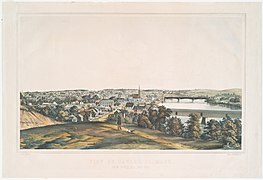
View of Haverhill, 1850
-

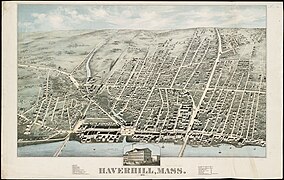
Map of Haverhill, 1876
-


City Hall, built 1889
-

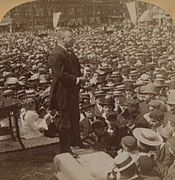
Teddy Roosevelt addressing crowd in Haverhill, 1902
-

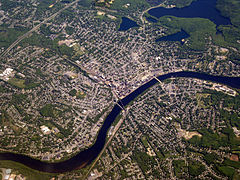
Aerial view of Haverhill, 2008
Geography
According to the United States Census Bureau, the city has a total area of 35.6 square miles (92.3 km), of which 33.0 square miles (85.4 km2) is land and 2.7 square miles (6.9 km), or 7.47%, is water. The city ranks 60th in the Commonwealth in terms of land area, and is the largest city or town in Essex County. Haverhill is drained by the Little and Merrimack rivers, the latter separating the Bradford section of town from the rest of Haverhill. The highest point in the city is found on Ayers Hill, a drumlin with two knobs of almost equal elevation of at least 335 feet (102 m), according to the most recent (2011-2012) USGS 7.5-minute topographical map. The city also has several ponds and lakes, as well as three golf courses.
Haverhill is bordered by Merrimac to the northeast, West Newbury and Groveland to the east, Boxford and a small portion of North Andover to the south, Methuen to the southwest, and Salem, Atkinson and Plaistow, New Hampshire, to the north. From its city center, Haverhill is 8 miles (13 km) northeast of Lawrence, 14 miles (23 km) southwest of Newburyport, 27 miles (43 km) southeast of Manchester, New Hampshire, and 32 miles (51 km) north of Boston.
Climate
Geology
The overall terrain within Haverhill is heavily influenced by various glacial formations. With drumlins, moraines, eskars, glacial erratics, and kettle ponds being common. Gravel mining operations are conducted along eskars and glacial deposites of readily accessible gravel.
Much of the soil within Haverhill is consolidated glacial till; inceptisols with moderate pedological development being the most common, as well as spodidols seen within the coniferous forests local to the area. Various fluvial deposits can be seen surrounding the river banks of the Merrimack and its tributaries.
The river systems within Haverhill have also been heavily altered by glacial activity, with drainage patterns being inconsistent and variable. Because of this inconsistency, and examples of each drainage pattern in some capacity being observable, streams and rivers within Haverhill would be classified as having a deranged drainage pattern.
Within close proximity of the Clinton-Newbury fault line, the bedrock topography of Haverhill is part of the Berwick Formation, consisting of metasandstone quartzite and sulfuric mica schists dating from the Silurian period. However other metamorphic rocks such as gneiss and shale are relatively common. Granite, feldspars, and other igneous silicates are also abundant.
Points of interest
- Main Street Historic District
- Museum of Printing
- Winnekenni Park Conservation Area, including Winnekenni Castle and Lake Saltonstall
Demographics
| Year | Pop. | ±% |
|---|---|---|
| 1790 | 2,408 | — |
| 1800 | 2,730 | +13.4% |
| 1810 | 2,682 | −1.8% |
| 1820 | 3,070 | +14.5% |
| 1830 | 3,896 | +26.9% |
| 1840 | 4,336 | +11.3% |
| 1850 | 5,877 | +35.5% |
| 1860 | 9,995 | +70.1% |
| 1870 | 13,092 | +31.0% |
| 1880 | 18,472 | +41.1% |
| 1890 | 27,412 | +48.4% |
| 1900 | 37,175 | +35.6% |
| 1910 | 44,115 | +18.7% |
| 1920 | 53,884 | +22.1% |
| 1930 | 48,710 | −9.6% |
| 1940 | 46,752 | −4.0% |
| 1950 | 47,280 | +1.1% |
| 1960 | 46,346 | −2.0% |
| 1970 | 46,120 | −0.5% |
| 1980 | 46,865 | +1.6% |
| 1990 | 51,418 | +9.7% |
| 2000 | 58,969 | +14.7% |
| 2010 | 60,879 | +3.2% |
| 2020 | 67,787 | +11.3% |
| * = population estimate. Source: United States census records and Population Estimates Program data. Source: U.S. Decennial Census | ||
As of the census of 2010, there were 60,879 people, 25,576 households, and 14,865 families residing in the city. The population density was 1,846.5 inhabitants per square mile (712.9/km2). There were 23,737 housing units at an average density of 712.2 per square mile (275.0/km). The racial makeup of the city was 88.3% White, 4.5% African American, 0.3% Native American, 1.6% Asian, 0.03% Pacific Islander, 4.30% from other races, and 2.6% from two or more races. Hispanic or Latino made up 14.5% of the population (5.8% Puerto Rican, 4.6% Dominican, 0.9% Mexican, 0.5% Guatemalan, 0.3% Salvadoran, 0.3% Colombian, 0.2% Cuban). 16.8% were of Irish, 14.6% Italian, 10.1% French, 9.0% English, 7.8% French Canadian and 6.3% American ancestry according to Census 2000.
There were 22,976 households, out of which 33.0% had children under the age of 18 living with them, 47.0% were married couples living together, 13.4% had a female householder with no husband present, and 35.3% were non-families. 28.6% of all households were made up of individuals, and 10.3% had someone living alone who was 65 years of age or older. The average household size was 2.51 and the average family size was 3.11.
In the city, the population was spread out, with 25.7% under the age of 18, 7.7% from 18 to 24, 33.5% from 25 to 44, 20.4% from 45 to 64, and 12.8% who were 65 years of age or older. The median age was 36 years. For every 100 females, there were 90.3 males. For every 100 females age 18 and over, there were 85.7 males.
The median income for a household in the city was $49,833, and the median income for a family was $59,772. Males had a median income of $41,197 versus $31,779 for females. The per capita income for the city was $23,280. About 7.0% of families and 9.1% of the population were below the poverty line, including 12.3% of those under age 18 and 10.0% of those age 65 or over.
Crime
| Haverhill | |
|---|---|
| Crime rates* (2020) | |
| Violent crimes | |
| Homicide | 2 |
| Rape | 11 |
| Robbery | 19 |
| Aggravated assault | 272 |
| Total violent crime | 304 |
| Property crimes | |
| Burglary | 144 |
| Larceny-theft | 411 |
| Motor vehicle theft | 83 |
| Arson | 6 |
| Total property crime | 638 |
Notes *Number of reported crimes per 100,000 population. 2020 population: 67,787 Source: 2020 FBI UCR Data | |
In 2019, Haverhill’s violent crime rate per 100,000 inhabitants was higher than the average rate of violent crime in both the state of Massachusetts and the nation as a whole. The rate of violent crime in Haverhill has declined in the past several years, however, from a recent peak of 391 in 2017 to a low of 304 in 2020.
Government
City government
Haverhill operates under a mayor–council form of government. The current mayor is James J. Fiorentini, who has been mayor of Haverhill since 2004 and was most recently re elected in 2021. The city council has nine members, elected every two years. The most recent election was during 2021.
State representation
Haverhill is represented in the state legislature by officials elected from the following districts:
- Massachusetts Senate’s 1st Essex district.
- Massachusetts House of Representatives’ 2nd Essex district
- Massachusetts House of Representatives’ 3rd Essex district
- Massachusetts House of Representatives’ 14th Essex district
- Massachusetts House of Representatives’ 15th Essex district
Education
Haverhill is the home of the main campus of Northern Essex Community College. Until its closing in 2000, Bradford College provided liberal arts higher education in Haverhill. In 2007, it became the new home of the Zion Bible College, now called Northpoint Bible College. The University of Massachusetts Lowell has a satellite campus in Haverhill in the Harbor Place building, and also offers several courses at Northern Essex Community College. Haverhill completed the reconstruction of the Hunking middle school in the Bradford part of the city. Haverhill is also home to the historic Walnut Square School, first built in 1898 at a cost of $30,000. The school’s tower clock was created by Mr. Edward Howard, a famous clock maker of the 1890s, at a cost of $1,300.
Public schools in the city are operated by the Haverhill Public Schools District.
In late October 2022, there was a strike initiated by Haverhill teachers as part of the local teacher’s union, the Haverhill Education Association (HEA). The purpose of this strike was to renegotiate teacher contracts as well as future salary increases to adjust for inflation. A lower average pay for the district in comparison to the overall state average lead to years of tension between the union and Haverhill school committee, eventually culminating in the strike. Schools closed for four days as negotiations proceeded between union representatives and members of the school committee. The strike ended after an agreement was met between both parties. Both the strike and the eventual agreement met were overwhelmingly supported by HEA members during internal votes within the union; with over 600 members supporting the strike and 25 against it, and 99% of the union supporting the eventual negotiated agreement.
Infrastructure
Transportation
Haverhill lies along Interstate 495, which has five exits throughout the city. The town is crossed by five state routes, including Routes 97, 108, 110, 113 and 125. Routes 108 and 125 both have their northern termini at the New Hampshire state border, where both continue as New Hampshire state routes. Four of the five state routes, except Route 108, share at least a portion of their roadways in the town with each other. Haverhill is the site of six road crossings and a rail crossing of the Merrimack; two by I-495 (the first leading into Methuen), the Comeau Bridge (Railroad Avenue, which leads to the Bradford MBTA station), the Haverhill/Reading Line Railroad Bridge, the Basiliere Bridge (Rte. 125/Bridge St.), the Bates Bridge (Rtes. 97/113 to Groveland), and the Rocks Village Bridge, to West Newbury, just south of the Merrimac town line. In 2010, a project began to replace the Bates Bridge, 60 feet (18 m) downstream, with a modern bridge. The project is expected to take two to three years and cost approximately $45 million.
MBTA Commuter Rail provides service from Boston’s North Station with the Haverhill and Bradford stations on its Haverhill/Reading Line. Amtrak provides service to Portland, Maine, and Boston’s North Station from the same Haverhill station. Additionally, MVRTA provides local bus service to Haverhill and beyond. The nearest small-craft airport, Lawrence Municipal Airport, is in North Andover. The nearest major airport is Manchester-Boston Regional Airport in Manchester, and the nearest international airport is Logan International Airport in Boston.
Notable people
- John Mapes Adams, Medal of Honor recipient during the Boxer Rebellion
- Mabel Albertson (1901–1982), actress
- Louis Alter (1902–1980), songwriter (“Do You Know What It Means to Miss New Orleans?”)
- Daniel Appleton (1785–1849), publisher
- William Henry Appleton (1814–1899), Daniel Appleton’s son, publisher of Lewis Carroll, Arthur Conan Doyle, Charles Darwin, Thomas Henry Huxley, Herbert Spencer, and John Stuart Mill
- Gerald Ashworth (1942- ) Track athlete and Olympic gold medal winner
- Bailey Bartlett (1750–1830), member of the United States Constitutional Convention
- Alexander Graham Bell (1847–1922), inventor, spent considerable time in Haverhill initially as a tutor to the deaf son of a prominent shoe magnate who later invested in Bell’s telephone concept
- John Bellairs (1938–1991), author of gothic horror fiction for children and young adults
- William Berenberg (1915–2005), Harvard University professor and pediatrician
- Tom Bergeron (born 1955), television personality, comedian, and game show host.
- Peter Breck (1929–2012), actor
- Isaac Newton Carleton (1832–1902), educator
- Walter Tenney Carleton (1867–1900), businessman
- Stuart Chase (1888–1985), economist
- Tristram Coffin, among the town’s first settlers, who later left to settle Nantucket
- Russ Conway (1949–2019), investigative journalist and Elmer Ferguson Memorial Award recipient
- David Crouse, writer
- Andre Dubus III (born 1959), novelist and short story writer
- Hannah Duston (1657–1736), colonial heroine, first woman in the United States to be honored with a statue
- Frank Fontaine (1920–1978), comedian, Crazy Guggenheim on The Jackie Gleason Show
- Jeff Fraza, boxer and contestant on reality television show The Contender
- Charlotte Fullerton, author and Emmy-winning children’s television writer/producer
- Jordan Harris (2000-), hockey player for the Montreal Canadiens
- Moses Hazen (1733–1803), Continental Army general
- Sylvia Hitchcock, Miss Alabama USA 1967, Miss USA 1967, Miss Universe 1967
- Red Howard (1900–1973), football player
- Duncan MacDougall, physician whose studies inspired the film 21 Grams
- Rowland H. Macy (1822–1877), merchant
- Louis Burt Mayer (1884-1957) American film producer and co-founder of Metro-Goldwyn-Mayer studios (MGM)
- Karen McCarthy, Missouri politician
- Charles Minot (1810–1866), railroad executive at Erie Railroad
- Bob Montana, Archie Comics co-creator
- William Henry Moody (1853–1917), Supreme Court justice, and prosecutor in the Lizzie Borden trial
- Carlos Peña, Major League Baseball player
- Anthony Purpura (born 1986), USA Rugby National Team player
- Effie Alberta Read (c. 1873–1930), scientist at the US Food and Drug Administration
- Stephen Robert (born 1940), former chairman and CEO of Oppenheimer & Co., former Chancellor of Brown University
- Seth Romatelli, actor, host of Uhh Yeah Dude
- James E. Rothman, notable cell biologist and Nobel Prize winner
- Joseph Ruskin (1924–2013), née Joseph Richard Schlafman, actor, had roles in four Star Trek series and films including The Magnificent Seven and Prizzi’s Honor
- Mike Ryan, Major League Baseball player
- Nathaniel Saltonstall (1639–1707), judge at the Salem witch trials
- Jon Shain (born 1967), folk musician
- Spider One, née Michael Cummings, musician, brother of Robert Cummings a.k.a. Rob Zombie
- Charles Augustus Strong (1862–1940), philosopher, of the American school of critical realism
- Noah Vonleh, professional basketball player for the Boston Celtics
- John Greenleaf Whittier (1807–1892), poet; his poem Snow-Bound is set in Haverhill
- Charlotte White (1782–1863), first unmarried American woman missionary, arrived India 1816
- Rob Zombie (born 1965), born Robert Cummings, musician and founding member of White Zombie, film director, mainly horror genre
See also
- List of mill towns in Massachusetts
Notes
Bibliography
External links
- City of Haverhill official website
★★★★★

